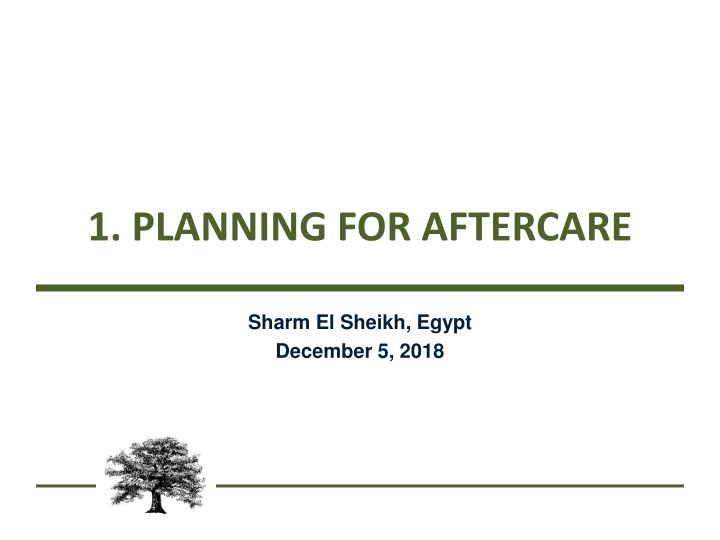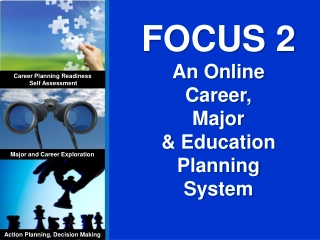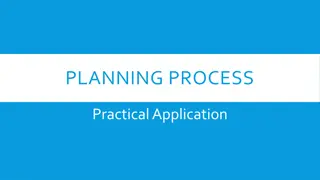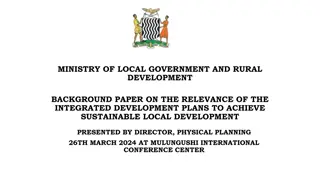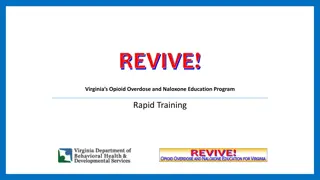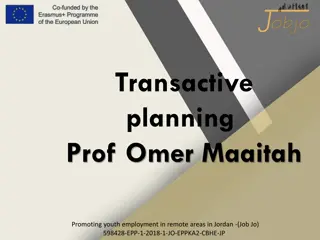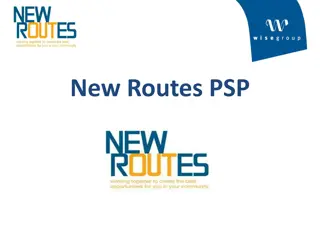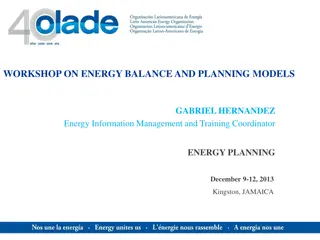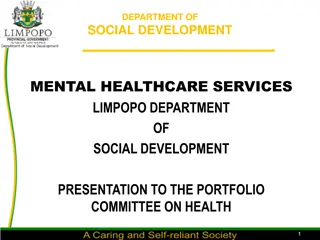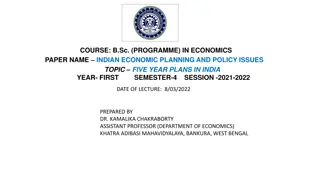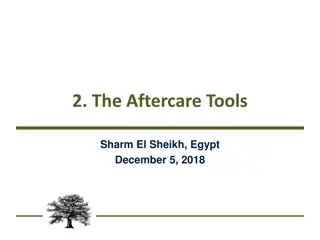PLANNING FOR AFTERCARE
Aftercare services in business focus on converting, retaining, embedding, expanding, and diversifying investments to enhance economic development. Understanding investor needs and maintaining relationships are key caveats for successful aftercare implementation.
Download Presentation

Please find below an Image/Link to download the presentation.
The content on the website is provided AS IS for your information and personal use only. It may not be sold, licensed, or shared on other websites without obtaining consent from the author.If you encounter any issues during the download, it is possible that the publisher has removed the file from their server.
You are allowed to download the files provided on this website for personal or commercial use, subject to the condition that they are used lawfully. All files are the property of their respective owners.
The content on the website is provided AS IS for your information and personal use only. It may not be sold, licensed, or shared on other websites without obtaining consent from the author.
E N D
Presentation Transcript
1. PLANNING FOR AFTERCARE Sharm El Sheikh, Egypt December 5, 2018
AFTERCARE Company-level services designed to facilitate the start-up and continuing development of a company Long List Short List Expand- Delocate Decision Start-Up Promotion/Targeting Start-up Servicing Operational Servicing Facilitation Strategic Collaboration Policy Advocacy Aftercare with a view towards maximizing its contribution to the local economic development.
Main objectives of Aftercare Convert: Improve low conversion rates Retain: Keep existing investors from leaving Embed: Extract benefits for development Expand: Get reinvestments Diversify: Guide investors to opportunities for other, higher value business activities. At the end, it is about maximizing the impact of investment in the economic development of your location
Translating aftercare services into business needs The success of aftercare depends greatly on understanding your investors needs and developing services which match these. Aftercare services can be categorized into 3 main types: Administrative services: facilitate the operations of firms. These may include obtention of licenses and permits to become operational. Operational services: support the effective and efficient operations of firms. They include support for training, identifying local suppliers & cluster development to improve productivity and competitiveness. Strategic services: influence the future direction of the firm, the development of new capabilities and the corporate development path in the host region. Their aim is to make sure that companies stay and continue to expand or upgrade their business activities.
The Key Caveats of Aftercare Establishing and maintaining relationships with investors. Either these already exist or these must be forged. Even if these exist, they need to be nurtured and new ones made. Establishing and maintaining relationships with public and private stakeholders who can help solve the investor needs. The Public Sector: Ease, Facilitate, Quicken and Formalize solutions. The Private Sector: Connect, Pool, Identify, Unlock resources to provide a solution. Aftercare is not about issues, it is about solutions!
Identifying the Scope of Action The core aftercare activity is visiting already established investors. Through these you will discover an opportunity to either: Convert; Retain, Embed, Expand or Diversify. The first decision when taking on an aftercare program is how proactive you want to be. Each goal of aftercare requires its own planning. Achieving every goal of aftercare is not always possible. Some of the goals of aftercare require a lot of preparation often years, such as in the case for example of embedding investment.
Identifying the Scope of Action Consulting specific stakeholders to prepare in advance a concrete and structured aftercare service offer. Visiting a carefully selected group of investors. Choosing and visiting with stakeholders a select group of investors The selection process can have multiple criteria. Reactive / Proactive Waiting for the investor to contact the IPI. Visiting companies. And recording investor issues. Criteria are generally sector based, though there are other criteria of interest. Proactive Proactive Reactive Trying to solve the issues or opportunities as these arise. Clear set of services which will be offered to each investor as per aftercare service program offer. Trying to solve investor grievances. No formal communication of issues or opportunities beyond IPI annual report. Clear set of services which can be offered for each target investor. Communicating such issues to the right authorities. Every stakeholder takes on agreed responsibility within program to service investor needs. Follow-up. Communicating such issues to the right authorities Communicating results of aftercare program within a policy advocacy program or forum.
Case study - Netherlands Source: World Bank Group Ministry of Economic Affairs Indirect Involvement Direct Involvement Bodies involved Other Ministries and Government Depts. Bilateral chambers (e.g. Amcham, etc) Embassies abroad Universities NFIA s offices abroad 6 regional IPA s/EDA s Municipal economic development staff (ad- hoc support) Netherlands Foreign Investment Agency (NFIA) (50 staff) One full time person at NFIA within Investment Projects division, managing the ID program. Supported by 6 dedicated Foreign Investor Relations Managers (FIRM) at partner IPAs. Highly decentralized approach - cooperation formalized in a Memorandum of Understanding. Coordination mechansim Sectors with highest value added to the Dutch economy. Companies in target sectors for investment promotion at the national and regional level. Foreign investors that are already fully operational. Regional IPA s propose own list of 50 companies in consultation with the NFIA. Target Group Promote networking among foreign and domestic companies Retain and anchor existing investors Provide key point of contact for investor Investor problem solving Product development Expansion projects Objectives
Case study - Czech Republic Source: World Bank Group Czech Ministry of Industry and Trade Indirect Involvement Direct Involvement Bodies involved Other Ministries and Government Depts. Embassies abroad Universities / schools Regional governor s Foreign and domestic chambers of commerce Council for Trade and Investment Association for Foreign Investments (AFI) CzechInvest Investment Department (70 staff) Account Management team (7 staff) within Project Management Dept. A client centered approach deliver quality Account Management / permanent contact Decentralized approach - enhanced support at the regional level Coordination mechansim Company selection based on FDI target sectors, significance of the investor, quality of existing investment project and potential for further development. Nationality of the investor is unimportant domestic and foreign 800 firms in total about 100 pro-active (approx. 40 category A firms) Target Group Attract new R&D or technology centers to Czech Rep. Provide key point of contact for investor Re-investment of profits in the Czech Rep. Investor problem solving Product development Expansion projects Objectives
Case study Pennsylvania Source: World Bank Group PA Governor s Office Deptm of Economic Development (DCED) Indirect Involvement Direct Involvement Bodies involved Extensive network of over 900 service providers , including other Government departments and private sector 10 regional BRE teams (210 people in total) Governor s Action Team Business Retention & Expansion Program (BREP) One full time Program Director at GAT managing the BRE program supported by 10 dedicated Regional Coordinators and 200 Business Liaison Officers based in the regions. GAT/BREP budget of $3 million allocated to each region directly based on population, number of companies in region and quantity of employment. Coordination mechansim Focus on all companies offering value-added products and services (threshold min. 5 employees) 9,000 company visits per year. No priority given to foreign investors. Statewide program for all investors located in PA. In particular, companies at risk of relocation or divestment are prioritized Target Group Support growth of existing investors through State incentive programs Provide key point of contact for investor Product development (ad-hoc) Retention of existing investors Investor problem solving Expansion projects Objectives
Establishing Targets: Results Driven Aftercare goals need to be put into context and thought through carefully. They must be guided by: Deep knowledge of existing conditions for investors; and A good understanding of issues faced by different sectors. The context must guide what is possible and what needs to be addressed to change the context to the desired goals. In order to achieve the desired goals, you need: Careful planning (strategy); and A list of clear targets. Targets are just desired outcomes from the planning put in place.
Establishing Targets: Results Driven Working with targets allows IPIs to monitor that the planned activities are providing the desired results. As with investment promotion and attraction, in aftercare, the final decision on whether an investment takes place is entirely the investor s decision. Targets provide a learning curve for all IPIs and gives them the chance to reorganize their activities based on what is learned from meeting with investors. As it is essential that partners work well together to be able to offer the right solutions, IPIs must also learn from the results of agreed collaborative actions.
Defining the level of Service and Resources No one single IPI can carry out aftercare activities effectively because investors generally need assistance from different actors to either: Solve their grievances; and / or To invest. Stock taking of available capacity at your institution. Be realistic. Not everyone can or must do most proactive aftercare activities. (Nor is it desirable) Also be clear, what is your most basic area of responsibility? Are you already are offering certain services to investors? Is it formalized in any way?
Defining the level of Service an Resources Once you have taken stock of your real capacity; Make sure you assign specific staff to act as focal points with investors and other institutions; Do you have a document outlining the main features of your location for investors as well as a list of the services you provide to investors? Assign a specific and detailed budget for aftercare activities as well as time dedicated to such activities. Then, it is time to define the main strategic guidelines of your aftercare plan. Decide what you want to achieve with your aftercare plan.
Identifying Target Investors - Prioritizing List of typical criteria used to select and prioritize target investors: Priority Sector. Priority region / location. Specifically selected as a priority by name. Potential to add more value, diversify, or integrate vertically. An announced company (needs to be converted). Known to have any of the problems on the key issues list Use advanced skills and/or technologies. Employment. Company have known plans to expand or disinvest.
A best practice framework for Aftercare Stage Best practice 1. Set objectives Clearly defined & shared with partner organisations 2. Define services Identification of agency added-value. Tailored services 3. Identify target group Prioritisation of sectors, companies (manageable number) 4. Develop approach to investors Pro-active, long term and at senior level 5. Regularity & coverage of visits At least twice a year 6. Status of individuals in visits Senior, sector expertise and dedicated client accounts 7. Project management arrangements Co-ordination at all levels and with private sector 8. Arrangements for source country Co-ordination with national agency and embassies 9. Decide level of resources High in time. Few dedicated staff, but large virtual team 10. Impact and success rates Clear targets and evaluation mechanism needed. At least yearly monitoring of inputs and outputs 16
Preparing for Execution Convert Design along with aftercare partners how to best approach and/or deal with investor implementation. Identify the investor road map for establishment. Meet with actors who can help fast-track implementation. Identify investors in the servicing stage. Contact and visit investors. - Agree with investors on a list of actions. - Meet with focal points to describe goals and targets. - Existing pipeline of investors. - Establishment procedures from different public stakeholders. - Establish a list of focal points for each level of procedures. - Assign one key actor to follow-up periodically through to implementation. - I.D. any existing bottlenecks. - Press - Direct contact by investors - Agree responsibilities.
Preparing for Execution Retain Meet with and discuss with relevant stakeholders existing or identified solutions or facilities. Filter list of identified investors and categorize into strategic and non-strategic. Select a manageable list, research investor, and research potential solutions to offer. Identify investors in danger of delocation. Contact and visit investors. - Meet with focal points to describe goals and targets. - Identify first through interview if the investor has impossible problems or delocation is imminent. - Direct contact by investors. - Key criteria for selection: strategic sector; tech or value added; size of employment and/or sales; impact within region; new and/or upcoming sector. - If criteria is sector, prepare first available solution package. - Be sure that the investor has not already contacted with relevant stakeholder to avoid duplicity. - Identify vulnerable sectors. - If criteria is other than sector, research company first and i.d. then potential solutions. - Provide solutions and agree on next steps if investor agrees. - Identify investors in underdeveloped areas. - Press and 3rd parties. - Agree on collaboration. - follow-up and prepare meetings and docs.
Preparing for Execution Expand / Embed / Diversify Prepare a list of services to investors within sector and / or general services list if non-sector specific Meet with and discuss with relevant stakeholders to agree on collaboration and plan of action. Identify investors / prepare sector specific inveestor visits Research sector or selected investors ahead of time. Contact and visit investors and/or invite to event -If an event, try to use your existing DB and that of your collaborating partner/s to invite the right target group to the event. - If list of sector specific or other criteria investors is large; plan aftercare over longer period of time and/or distribute among interested partners. -Prepare relevant data on new opportunities (through i.e. new legislation; upcoming trends in the sector or region; new training programs and financing mechanisms) - Direct contact by investors. - Press and 3rd parties. - Meet with focal points to describe goals and targets. - Make sure that you work with identified partner to set up and organize the visits. - ID through investor visits. - Be sure that the investor has not already contacted with relevant stakeholder to avoid duplicity. - Service list will be similar to promotion list of services. - Include other criteria of strategic importance: tech or value added; size of employment and/or sales; impact within region; new and/or upcoming sector. - See if preparing a joint event with a partner to present the opportunity to investors may be desirable. - The aftercare visit should not just serve to present opportunity but also to collect data on the investor and update. - If country or region wise wider strategy, make sure to include as a guide to develop service list - Agree on collaboration.
